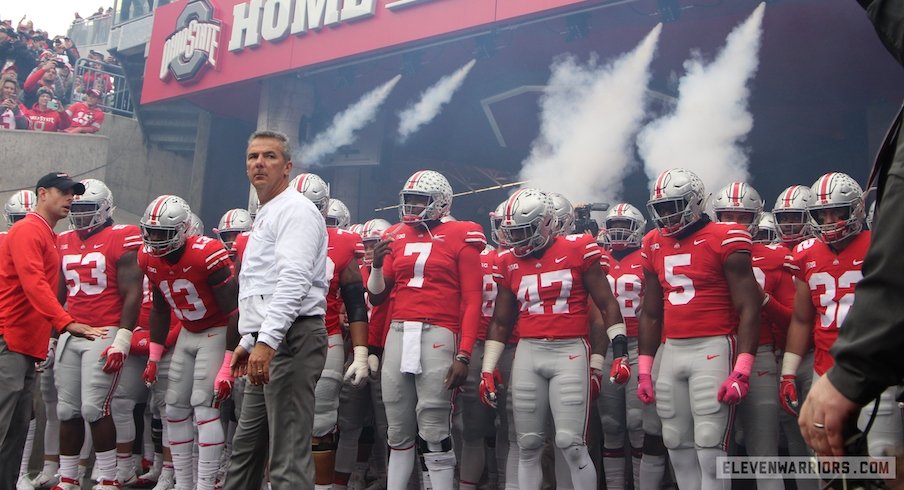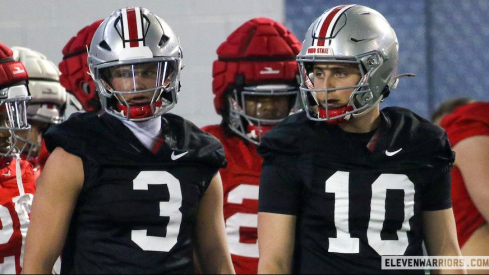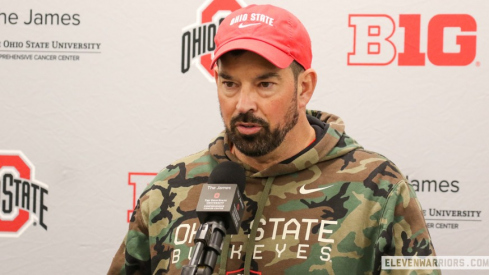Sure, Ohio State beat Minnesota 30-14 to remain unbeaten after seven weeks, but it didn’t exactly feel like the convincing beatdown one might imagine the third-ranked team would put on an unranked team entering Saturday with a 3-2 record and a true freshman starting at quarterback.
Until late in the second quarter the Golden Gophers hung around. At times this season, the Buckeyes have looked vulnerable – beatable, even. Minnesota exposed seemingly all of their vulnerabilities in one game.
Ohio State struggled to run effectively, had issues blocking Minnesota’s front seven, didn’t get much of a pass rush, allowed the Golden Gophers to average 5.4 yards per carry, and despite picking off two passes, allowed 16.8 yard per completion. Still, the performance culminated in a two-touchdown win. After the game, Urban Meyer noted the areas of concern and said the team will work on the issues this upcoming week.
"I don't think we played particularly well today. We'll know more when we get a film grade, and I'll let you know on Monday how they played," Meyer said. "We gave up three sacks. We have to keep Dwayne upright. Short yardage is not a strength. Red zone is not a strength, and running the ball is not a strength. That's something we've got to get figured out."
"The offense, not everything's going to be pretty," Dwayne Haskins said. "There's going to be adversity no matter who we play, especially a team like Minnesota. They're a great defense. We just had to fight through adversity, made the plays when they mattered, and that's a good learning tool for next week."
"The saying right now that I'm using is enhance our strengths and let's fix our weaknesses," Meyer said. "We're going to have to get some things fixed. What we're going to do is enjoy our win, 7-0. Not many teams are 7-0. Get some things fixed and get ready for the trip to Purdue."
Some of the biggest issues in Ohio State’s seventh win of the season came offensively. The Buckeyes continued their week-by week decline in the run game. They had their lowest yards-per-carry total of the season thus far.
Without Ohio State able to utilize a dual-threat quarterback, defenses can key on the running back – or, infrequently, a wide receiver coming across the formation in motion – to get the handoff nearly every time. But that, plus the amount of people crowding the line, isn't a worthy excuse in the eyes of offensive coordinator Kevin Wilson.
“I don't think (the box is) full all the time,” Wilson said. “There's still some times where those numbers are equated enough. They're not playing Cover 2, third and long they might pay some true pass coverage. At the end of the day, that's a cop out. I don't care if there's an extra guy is there, we've got to play behind our pads as an offensive line, tight end group, running back group and run the ball better.”
Meyer expressed his desire to see improvement out of the offensive line, but offensive coordinator Kevin Wilson noted Ohio State needs to see improvement run blocking throughout the offense.
"We have to continue to have that edge that Ohio State's had for years and years and years and we've always had," Meyer said.
“When you say you're not running the ball sometimes, you say, 'Well, it's the o-line.' No, it's not,” Wilson said. “Sometimes, it's the tight end. Sometimes, it's the perimeter guys. When you're running the ball well, it takes 11. When you're throwing the ball well, it takes 11. We're throwing the ball pretty good with 11. We've got to get the run game going with 11 guys.”
Haskins tossed for 412 yards, becoming the first quarterback in Ohio State history to have back-to-back 400-yard-plus games.
But still, the offense didn't move the ball consistently down the field nearly as well as he hoped with the run game a major question mark. The Buckeyes converted fewer than 50 percent of their third downs and were stuffed once on third downs. Plus, though they scored in two-of-three trips to the red zone, they settled for field goals from fewer than 30 yards out.
"I'm pretty sure they're a top five defense in the country," Haskins said. "What they did, they do it well. They're very consistent. We shot ourselves in the foot a couple of times with some penalties, some very long situations, first long situation. Put ourselves behind the ball a couple times.”
"Of course we wanted to finish a couple of drives, score some touchdowns, and have some penalties, but I wouldn't say frustration," Haskins said. "Just like we have higher expectations for ourselves than what we do sometimes on the field. Today was just figuring out what worked and then going out and executing."
After the game, Wilson brought up a topic that no coach had previously discussed. With a first-year quarterback who plays such a different style than any signal-caller Meyer had ever before coached, Ohio State has significantly altered its offense in terms of which plays are called. Haskins has said before that the plays remain the same, but which plays are called and the frequency of that has changed.
This year, the Buckeyes have not managed to get on consistent rolls with their play-calling, Wilson hinted, due to the use of many different plays, players and formations.
“We keep doing a lot of formations, so we get a lot of plays and you're popping here and there versus you're getting some rhythm, getting some consistency,” Wilson said.
“We've got to find that rhythm early,” Wilson said. “I think, again, sometimes with the players we've got, formations we've got, passing we've got, sometimes you try to complement so much, we're having a hard time getting our run game rhythm going. That's not an excuse. We've just got to find that. And as coaches, we spend a lot of time on it, we work at it, but we've got to be better than we are.”
At the end of the day, though, how teams travel the field and reach the end zone doesn't much matter. It's all about how large a team can get that number on the scoreboard, as Wilson reminded everyone as he wrapped up his post-game interview.
“It's college football, man,” Wilson said. “Light it up. Light it up. It's college football, man. Got to score points.”


